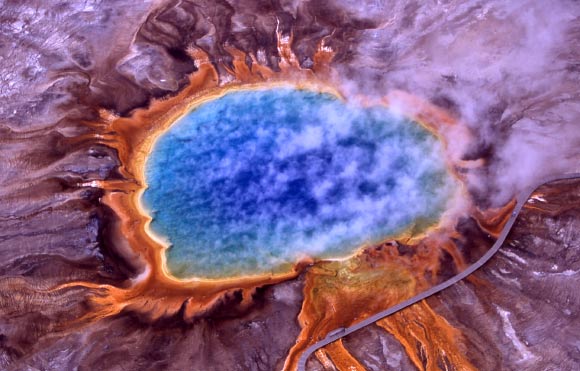An international team of biologists from Australia and the United States has discovered two new species of methane-metabolizing archaea.

Archaea were first found in extreme environments, such as volcanic hot springs; pictured here is Grand Prismatic Spring of Yellowstone National Park. Image credit: Jim Peaco / National Park Service.
The discovery was made using techniques that sequence DNA on a large scale and assemble these sequences into genomes using advanced computational tools.
“We sampled the microorganisms in the water from a deep coal seam aquifer 1,970 feet (600 m) below the Earth’s surface in the Surat Basin, near Roma, Queensland, and reconstructed genomes of organisms able to perform methane metabolism,” explained Dr Gene Tyson of the University of Queensland, senior author of a paper in the journal Science.
“Traditionally, this type of methane-metabolizing organisms occurs within a group of microorganisms called Euryarchaeota.”
The newly-discovered archaea belong to a group called the Bathyarchaeota (from the Greek ‘bathys’, meaning deep as it locates deep branching with Thaumarchaeota and Aigarchaeaota).
The Bathyarchaeota – formerly known as the Miscellaneous Crenarchaeotal Group – is an evolutionarily diverse group of microorganisms found in a wide range of environments.
“To use an analogy, the finding is like knowing about black and brown bears, and then coming across a giant panda. They have some basic characteristics in common, but in other ways these they are fundamentally different,” Dr Tyson explained.
“This makes us wonder: how many other types of new ‘bears’ or of methane-eating microorganisms are out there, that science has still not identified?”
The significance of the research is that it expands our knowledge of diversity of life on Earth and suggests we are missing other organisms involved in carbon cycling and methane production.
_____
Paul N. Evans et al. 2015. Methane metabolism in the archaeal phylum Bathyarchaeota revealed by genome-centric metagenomics. Science, vol. 350, no. 6259, pp. 434-438; doi: 10.1126/science.aac7745







